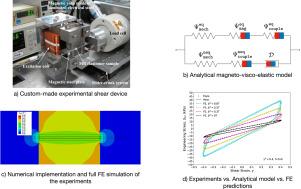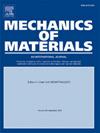A continuum magneto-viscoelastic model for isotropic soft magnetorheological elastomers: experiments, theory and numerical implementation
IF 3.4
3区 材料科学
Q2 MATERIALS SCIENCE, MULTIDISCIPLINARY
引用次数: 0
Abstract
This study deals with the experimental, theoretical and numerical investigation of the nonlinear viscoelastic response of magnetically soft magnetorheological elastomers (commonly known as -MREs and denoted here simply as MREs) subjected to combined magnetic and simple shear loads. We consider a fairly soft mechanically MRE. The experiments show a strong effect of the magnetic field on the resulting viscosity and hence dissipated energy expanded by the material during a simple shear cycle. Moreover, the effect of frequency on the response is weak indicating strongly nonlinear viscous effects similar to non-Newtonian fluids. An analytical magneto-viscoelastic model is proposed exhibiting magneto-mechanical coupling at both equilibrium and non-equilibrium energies as well as on the dissipation potential. The model is calibrated by solving in a semi-analytical way a simplified boundary value problem (BVP) of an infinite thin MRE strip embedded in an infinite air domain. These simplified solutions are cross-validated by full-field finite element simulations of the experimental setup showing very good agreement between the experimental data and model estimates. This illustrates the validity of the simplified material model for the proposed experimental setup and sets the ground for a more universal experimental protocol to characterize properly the finite strain response of MREs more generally.

各向同性软磁流变弹性体的连续磁-粘弹性模型:实验、理论和数值实现
本研究涉及磁软磁流变弹性体(通常称为 s-MRE,在此简称为 MRE)在磁力和简单剪切力联合载荷作用下的非线性粘弹性响应的实验、理论和数值研究。我们考虑的是一种相当软的机械磁流变弹性体。实验表明,磁场对材料在简单剪切循环过程中产生的粘度以及由此产生的能量耗散有很大影响。此外,频率对响应的影响很弱,这表明存在类似于非牛顿流体的强非线性粘滞效应。我们提出了一个磁-粘弹性分析模型,该模型在平衡和非平衡能量以及耗散势上都表现出磁-机械耦合。该模型通过半解析方式求解嵌入无限空气域中的无限薄 MRE 带的简化边界值问题 (BVP)进行校准。实验装置的全场有限元模拟对这些简化解进行了交叉验证,结果表明实验数据与模型估计值之间非常吻合。这说明了简化材料模型对拟议实验装置的有效性,并为更普遍地正确描述 MRE 有限应变响应的更通用实验协议奠定了基础。
本文章由计算机程序翻译,如有差异,请以英文原文为准。
求助全文
约1分钟内获得全文
求助全文
来源期刊

Mechanics of Materials
工程技术-材料科学:综合
CiteScore
7.60
自引率
5.10%
发文量
243
审稿时长
46 days
期刊介绍:
Mechanics of Materials is a forum for original scientific research on the flow, fracture, and general constitutive behavior of geophysical, geotechnical and technological materials, with balanced coverage of advanced technological and natural materials, with balanced coverage of theoretical, experimental, and field investigations. Of special concern are macroscopic predictions based on microscopic models, identification of microscopic structures from limited overall macroscopic data, experimental and field results that lead to fundamental understanding of the behavior of materials, and coordinated experimental and analytical investigations that culminate in theories with predictive quality.
 求助内容:
求助内容: 应助结果提醒方式:
应助结果提醒方式:


